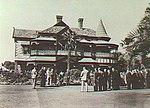Rose Park, South Australia

Rose Park is a suburb with a population of 1,374 in the South Australian capital city of Adelaide. It is located 1 kilometre (0.62 mi) east of Adelaide's central business district. Rose Park is a leafy, tree-lined and wealthy inner suburb containing a number of historical and contemporary attractions. Much of the area's 19th-century housing stock has been recognised with heritage protection. Part of the Burnside Council, it is bounded to the north by Kensington Road, to the east by Prescott Terrace, to the south by Dulwich Avenue and to the west by Fullarton Road. The area is mainly residential in nature, with commercial buildings along Fullarton Road, Kensington Road, and Dulwich Avenue. This places it on the very edge of the Adelaide Park Lands, bordering Victoria Park.
Excerpt from the Wikipedia article Rose Park, South Australia (License: CC BY-SA 3.0, Authors, Images).Rose Park, South Australia
Alexandra Avenue, Adelaide Rose Park
Geographical coordinates (GPS) Address Nearby Places Show on map
Geographical coordinates (GPS)
| Latitude | Longitude |
|---|---|
| N -34.93072 ° | E 138.62798 ° |
Address
Alexandra Avenue
Alexandra Avenue
5067 Adelaide, Rose Park
South Australia, Australia
Open on Google Maps






